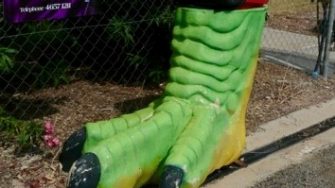
Date: Friday, October 6, 2017
Project: Eastern Australian Waterbird Survey
We headed down to the Channel Country Rivers this morning for one of the longest days in the plane. So a pre-sunrise start saw us in the air to catch the lights of the Mt Isa mining complex as we left the city.
Photos: Terry Korn
The Georgina river water holes were low and contained few birds. This was a disappointment but not unexpected as the impact of the drought could be clearly seen by the condition of the paddocks and the low levels of water in homestead dams.
Our half way stop was at the township of Winton which prides itself on two things: Jurassic dinosaurs and being the founding point of QANTAS. The little air terminal has novel waste bins in the form of dinosaur feet. The inside of the terminal proudly tells the story of QANTAS.
Photos: Terry Korn
Temperatures increased to the low thirties after we left Winton so it was rather bumpy for the rest of the 4hr 15m to Rockhampton.
One of the most exciting lakes for water birds in eastern Australia is Lake Galilee when it has water. This year we were rewarded with three of the basins having water from local rain which attracted tens of thousands of ducks, mainly Grey teal, some Pink-eared ducks and thousands of Black-tailed native hens. Small groups of Red-necked avocets and a group of about 100 small waders were also present. Of course Black swans were there along with some pelicans. Local rain was responsible for the partial filling of Lake Galilee.
Photos: Terry Korn
Further east of the giant open cut coal mining area recent rain had recharged many of the floodplain wetlands which hosted the usual numbers of Black duck, Grey teal, Egret, White-faced heron, White -necked heron and Little black cormorant. But there were small mobs of the daintily beautiful Green pygmy geese. These are a delight to see in flight. Stately Brolga were also common on the many lagoons and farm dams.
